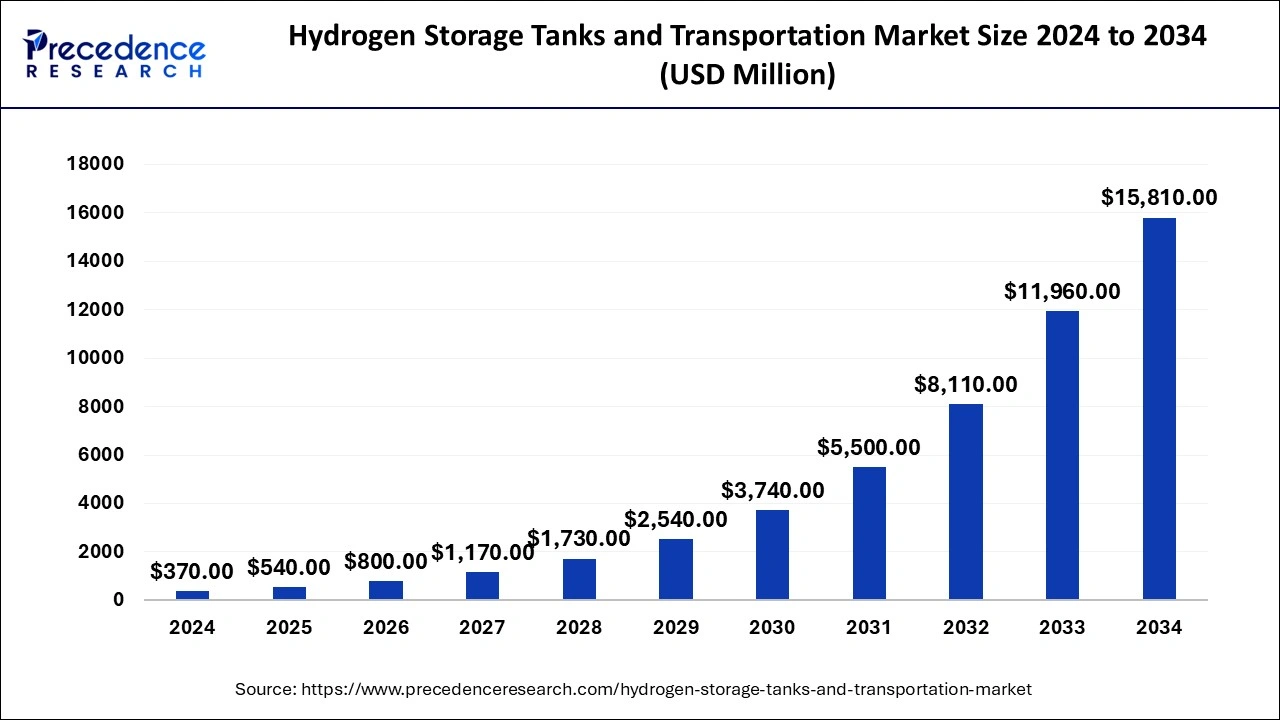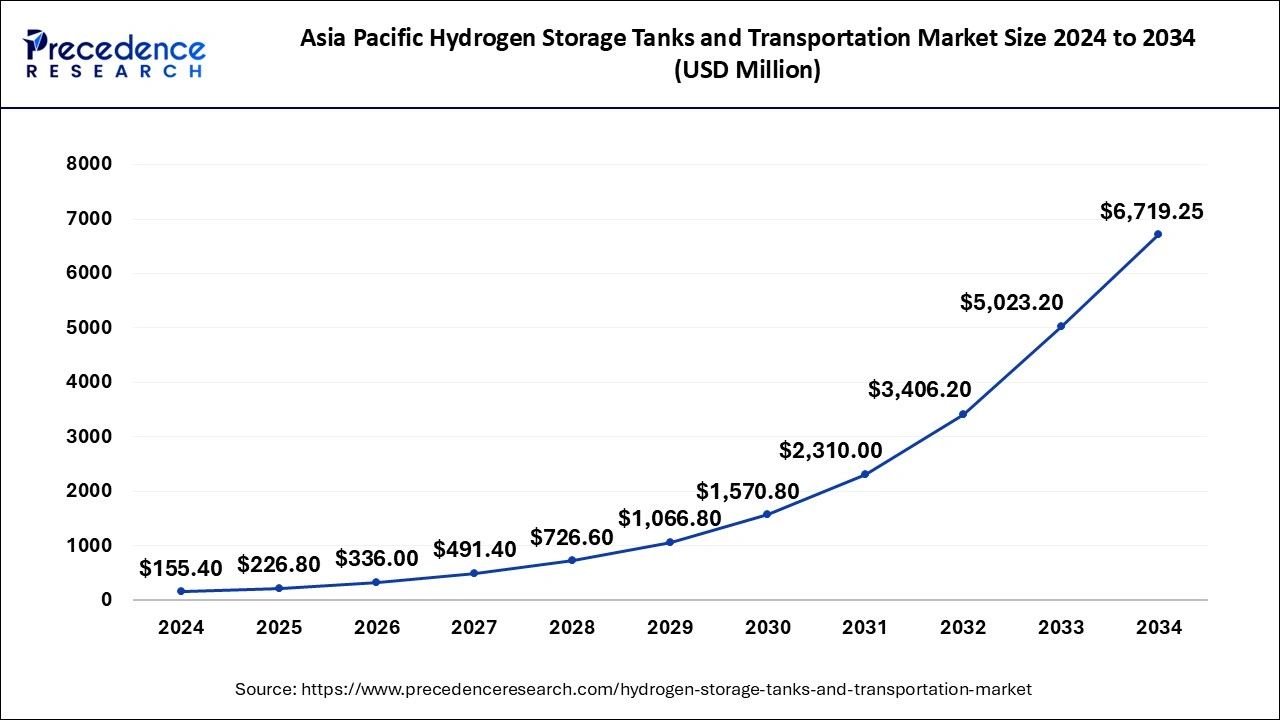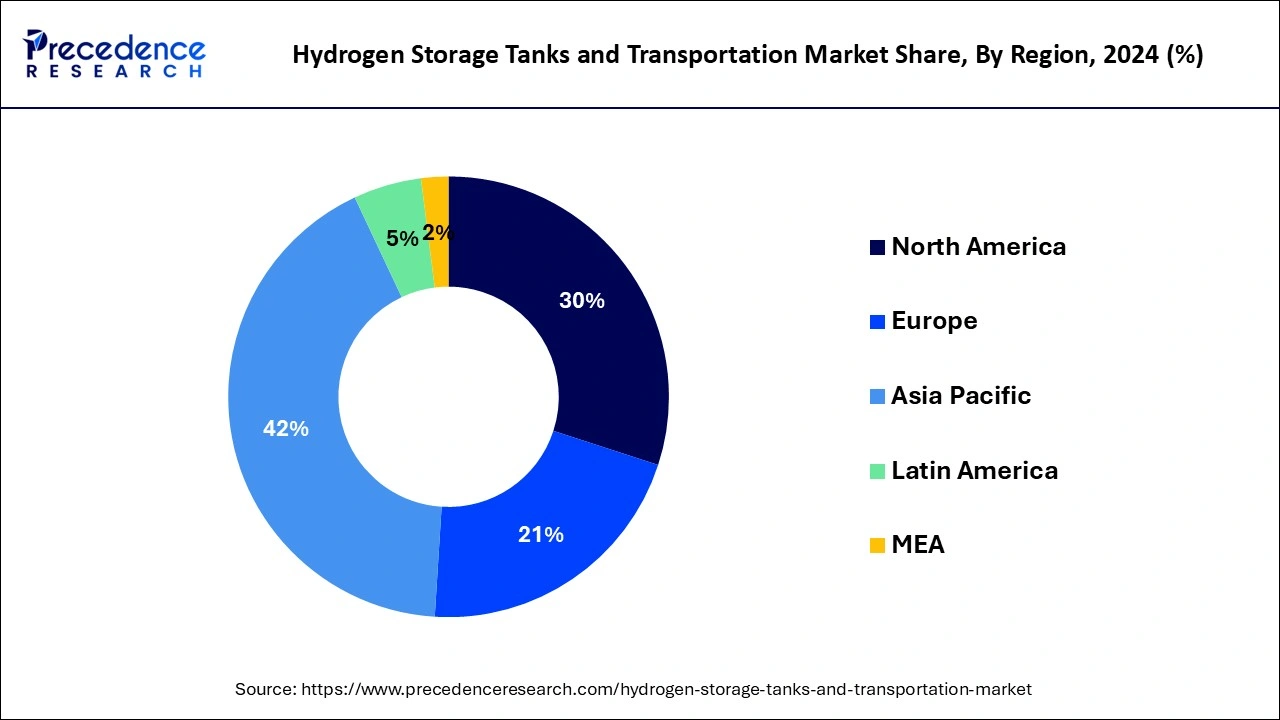May 2024
The global hydrogen storage tanks and transportation market size is calculated at USD 540 million in 2025 and is forecasted to reach around USD 15,810 million by 2034, accelerating at a CAGR of 45.57% from 2025 to 2034. The Asia Pacific hydrogen storage tanks and transportation market size surpassed USD 226.80 million in 2025 and is expanding at a CAGR of 45.74% during the forecast period. The market sizing and forecasts are revenue-based (USD Million/Billion), with 2024 as the base year.
The global hydrogen storage tanks and transportation market size was estimated at USD 370 million in 2024 and is predicted to increase from USD 540 million in 2025 to approximately USD 15,810 million by 2034, expanding at a CAGR of 45.57% from 2025 to 2034.

The Asia Pacific hydrogen storage tanks and transportation market size was valued at USD 155.40 million in 2024 and is expected to reach around USD 6,719.25 million by 2034, growing at a CAGR of 45.74% from 2025 to 2034.

Asia-Pacific held the largest market share of 42% in 2024 due to robust industrialization, government support for hydrogen initiatives, and a growing focus on clean energy. Countries like Japan and South Korea lead in adopting hydrogen technologies for diverse applications. The region's commitment to reducing carbon emissions and promoting sustainable energy solutions has spurred investments in hydrogen infrastructure. Additionally, Asia-Pacific's expanding automotive and industrial sectors contribute to the substantial market share, making it a key player in the global transition toward hydrogen as a clean energy source.

North America is poised for rapid growth in the hydrogen storage tanks & transportation market due to increasing initiatives for a clean energy transition. With a focus on reducing carbon emissions, governments and industries are investing in hydrogen infrastructure. Favorable policies, technological advancements, and a growing awareness of hydrogen's potential are driving the demand for storage and transportation solutions. The region's commitment to sustainable practices positions it as a key player in fostering the growth of the hydrogen economy, making North America a promising market for further development.
Meanwhile, Europe is witnessing significant growth in the hydrogen storage tanks & transportation market due to robust support from governments, driven by ambitious climate goals. The European Union's increased focus on reducing carbon emissions has spurred investments and policies favoring hydrogen technologies. Advancements in renewable hydrogen production and a growing emphasis on clean energy solutions contribute to the expansion of storage and transportation infrastructure. This growth aligns with Europe's commitment to sustainable practices, positioning hydrogen as a key player in the region's efforts towards a greener and more sustainable energy future.
Hydrogen storage tanks and transportation refer to the systems and methods designed to store and move hydrogen gas, a clean and versatile energy carrier. These technologies play a crucial role in the emerging hydrogen economy, where hydrogen is seen as a sustainable solution for various applications, including fuel cells in vehicles and industrial processes. Hydrogen storage tanks are containers that safely hold and store hydrogen until it's needed for use. The transportation aspect involves the development of secure and efficient methods for transporting hydrogen from production facilities to end-users. This often includes pipelines, trucks, or specialized vessels. As the demand for clean energy alternatives grows, advancements in hydrogen storage and transportation are vital for the widespread adoption of hydrogen as a clean and sustainable energy source.
| Report Coverage | Details |
| Growth Rate from 2025 to 2034 | CAGR of 45.57% |
| Market Size in 2025 | USD 540 Million |
| Market Size by 2034 | USD 15,810 Million |
| Base Year | 2024 |
| Forecast Period | 2025 to 2034 |
| Segments Covered | By Material and By Pressure |
| Regions Covered | North America, Europe, Asia-Pacific, Latin America, and Middle East & Africa |
Rising demand for clean energy
The growing global demand for clean energy is a powerful catalyst for the increasing popularity of hydrogen, leading to a surge in demand for hydrogen storage tanks & transportation solutions. As the world shifts towards environmentally friendly energy alternatives, hydrogen emerges as a clean and versatile option. Governments, industries, and consumers are increasingly recognizing the potential of hydrogen to reduce carbon emissions and contribute to a more sustainable future.
This rising demand for clean energy propels the need for effective storage and transportation infrastructure. Being a lightweight gas, hydrogen requires specialized storage tanks and reliable transportation methods to ensure its safe and efficient delivery to end-users. The market for hydrogen storage tanks & transportation responds to this demand by offering innovative solutions that meet safety standards, facilitate convenient transportation, and support the integration of hydrogen into diverse applications, further solidifying hydrogen's role in the global clean energy transition.
Limited hydrogen production
The limited production of hydrogen poses a significant constraint on the growth of hydrogen storage tanks & transportation market. Hydrogen is a crucial component for various applications, including clean energy and industrial processes. However, challenges in scaling up cost-effective and sustainable methods of hydrogen production restrict the overall supply available for storage and transportation. The scarcity of hydrogen affects the market by constraining its accessibility and affordability. With limited hydrogen production, the demand for storage tanks and transportation infrastructure is hindered, as there is not enough supply to warrant widespread adoption.
Addressing the bottleneck in hydrogen production is essential for unlocking the full potential of the hydrogen storage tanks & transportation market, allowing it to play a more significant role in the global transition toward cleaner energy alternatives. Efforts to enhance and expand hydrogen production methods are crucial for meeting the increasing demand and facilitating the growth of the entire hydrogen ecosystem.
Rapid growth in renewable hydrogen production
The rapid growth in renewable hydrogen production is creating significant opportunities in the hydrogen storage tanks & transportation market. With a heightened emphasis on sustainable energy, the increasing production of hydrogen through methods like electrolysis powered by renewable sources presents a favorable environment for the market's expansion. Renewable hydrogen, produced using clean energy, aligns with global sustainability goals, driving the demand for storage tanks and transportation infrastructure.
As renewable hydrogen gains momentum, the market for storage and transportation solutions stands to benefit from the surge in demand. The need for efficient and secure storage facilities, as well as reliable transportation methods, becomes crucial in supporting the distribution and utilization of renewable hydrogen. This trend not only promotes environmental sustainability but also positions the market as a key player in facilitating the transition to a cleaner and more sustainable energy landscape.
The carbon fibers segment held the highest market share of 52% based on the material. In the hydrogen storage tanks & transportation market, the carbon fibers segment involves the use of carbon fiber-reinforced materials for constructing lightweight and high-strength storage tanks. Carbon fibers offer exceptional strength-to-weight ratio, making them ideal for enhancing the structural integrity of hydrogen storage systems. The trend in utilizing carbon fibers for hydrogen storage tanks is driven by the pursuit of lightweight solutions, contributing to improved energy efficiency and safety standards in the transportation and storage of hydrogen, supporting the overall growth of the market.
The metals segment is anticipated to witness rapid growth at a significant CAGR of 34.7% during the projected period. In the hydrogen storage tanks & transportation market, the metals segment primarily refers to the use of metal materials in the construction of storage tanks and transportation infrastructure for hydrogen. Metals such as steel and aluminum are commonly employed due to their durability and strength, ensuring the safety and integrity of hydrogen containment. Recent trends in the metals segment of the market include advancements in alloy compositions to enhance corrosion resistance and reduce weight, contributing to more efficient and sustainable hydrogen storage and transportation solutions. These trends aim to address safety concerns and optimize the performance of metal-based hydrogen storage technologies.
The 200 - 500 bar segment has held 46% market share in 2024. The 200-500 bar segment in the hydrogen storage tanks & transportation market refers to storage and transportation systems designed to handle hydrogen at pressures ranging from 200 to 500 bar. This segment is crucial for applications requiring high-pressure storage, such as fueling stations and industrial processes. The trend in this segment involves advancements in materials and technologies to enhance safety, efficiency, and capacity, meeting the increasing demand for high-pressure hydrogen storage solutions in various sectors as hydrogen gains prominence as a clean energy source.
The above 500 bar segment is anticipated to witness rapid growth over the projected period. The segment in the hydrogen storage tanks & transportation market refers to storage systems that can withstand pressures exceeding 500 bar (bar is a unit of pressure). These high-pressure tanks are crucial for efficiently storing hydrogen gas. In recent trends, there's a growing emphasis on developing advanced materials and engineering techniques to enhance the safety and efficiency of above 500 bar storage solutions. This segment caters to applications where high-pressure hydrogen is required, such as certain industrial processes and specific types of hydrogen-powered vehicles.
By Material
By Pressure
By Geography
For inquiries regarding discounts, bulk purchases, or customization requests, please contact us at sales@precedenceresearch.com
No cookie-cutter, only authentic analysis – take the 1st step to become a Precedence Research client
May 2024
February 2025
July 2024
September 2024